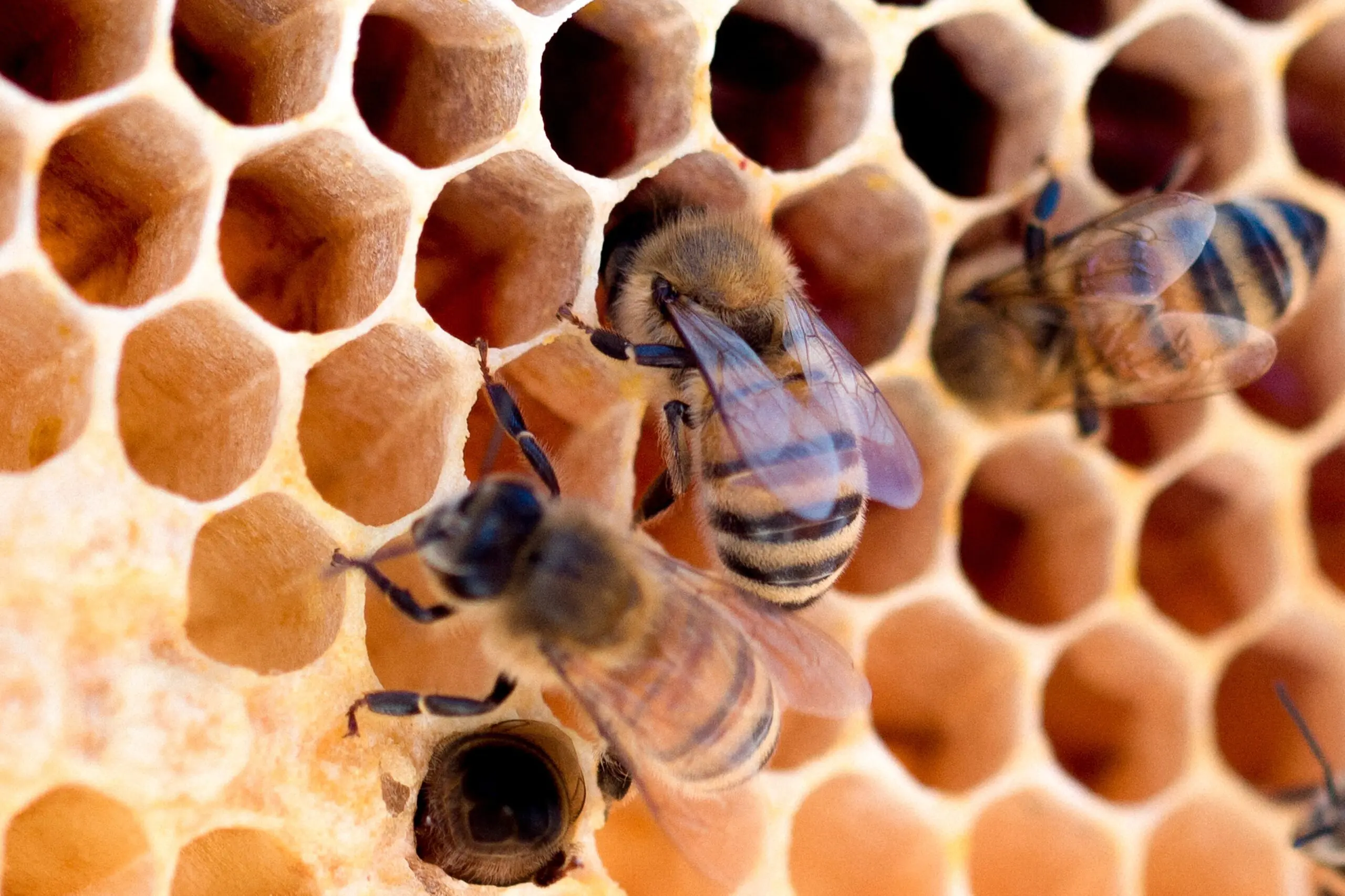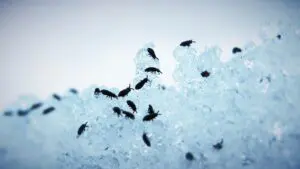

When the warm weather disappears, so does the familiar buzzing of bees. Have you ever wondered where the bees go when winter arrives? Read on to find out!
Bee Life Cycle
A bee’s life occurs in four stages- egg, larva, pupa, and adult. Depending on the species, bee eggs are either laid in a honeycomb hole or a solitary beehive cell. Bee eggs are white, elongated, and smaller than a grain of rice.
After about 3 days, the eggs hatch into larvae that resemble maggots in appearance. They are slightly over half an inch in length. Larvae are cared for 24 hours a day by worker bees. For the first few days after hatching, larvae are fed royal jelly, which is a fluid produced by worker bees. During the following few days, larvae are fed “beebread” which is a mixture of pollen and honey. When they have grown enough, the birth cell is closed off to allow the larva to develop into a pupa.
During the pupal stage, bees are left alone in their cells to grow. This stage is similar to a caterpillar entering its cocoon to become a butterfly. As they grow, bee pupae begin to resemble adult bees. They grow wings, eyes, legs, and more. Once they reach adulthood, they chew their way out of their cell.
All adult bees belong to one of three castes. Which caste a bee populates depends on their gender. All male bees are drones, and their sole purpose is to mate with the queen. Almost all female bees are workers. They are responsible for gathering food, protecting the hive, and caring for the young. Queens are the largest in size and smallest in population out of all of the castes. They are responsible for laying eggs to repopulate the hive. If a queen bee dies, the worker bees work quickly to condition an egg or larvae to become the new queen.
Fun Fact: Did you know worker bees communicate with each other using a special dance? One worker bee will tell the others where to go to gather nectar by wiggling her abdomen and walking in a figure-eight pattern. Her body position while dancing is what indicates to the others where to go- if her abdomen points up, the others should fly in the direction of the sun. If her body points down, the others fly in the opposite direction of the sun’s position, and the length of the dance indicates how far to fly. But what happens if the sun is covered with clouds? Well during their youth, bees learn how the sun moves. So, thanks to their internal clock, worker bees always know the sun’s location as well as how quickly it is moving across the sky.
Where do bees go during the winter?
Now to answer the most pressing question: where do bees go during the winter? The answer to this question depends on the kind of bee. Let’s take a look at the three bee methods of overwintering:
Overwintering as a Colony
Honey bees are one of the species known for overwintering as a colony. The colony that lives through the winter looks a little different than it does during the rest of the year, though. As the weather begins to cool down, the male drone bees die off, leaving only the queen and the workers. The newest generation of workers, a.k.a. the ones that live through the winter, have different physiological characteristics than the summer generations. The bees of the winter generation are more plump to retain heat, and they have a much longer lifespan in order to survive the entire winter. While most worker bees live for around 5 to 6 weeks, the winter generation lives for 4 to 6 months.
To keep warm inside the hive, the workers form a cluster around the queen. They shiver their wings to raise the temperature of the hive. The temperature at the center of the cluster can reach as high as 90° to 100° Fahrenheit, while the edges of the cluster hover around 50° Fahrenheit. Throughout the winter, the bees feed on the reserves of food that they built up during the summer. They do not start leaving the hive until outdoor temperatures are consistently above 50° Fahrenheit.
Overwintering as a Fertilized Queen
Species like bumble bees spend the warm seasons living in a colony. When the winter arrives, all members of the colony die except for the queen. Before this happens though, during the late summer, male bees mate with the queen. The newly mated queen does not lay her eggs right away. When the rest of the colony has died off, the fertilized queen enters a period of nutrient storage. The nutrients gathered during this period will gradually metabolize throughout the winter, keeping her fed. Next, the queen finds a warm, protected place to “hibernate,” usually underground. She enters diapause, which is essentially a state of physiological dormancy during which development is paused. She will remain in this state until outdoor temperatures are consistently warm.
After the winter, the queen emerges to forage for food and build a new nest. She finally lays her eggs, which hatch mostly female workers at first. She continues to lay eggs throughout the warm seasons until, during the late summer, males seek out new queens, thus beginning the cycle all over again.
Overwintering as a Larva or Pupa
Most solitary bee species spend the winter as larvae or pupae. During a female solitary bee’s life, she builds a nest with several birth cells. She stocks each cell with beebread. As the weather begins to cool, she mates and then lays her eggs in her nest, one egg per cell. Adult solitary bees, both male and female, subsequently die off before the winter. The newly laid eggs hatch and develop through the larval and pupal stages. No matter what stage they reach before winter, the immature bees enter diapause when the weather becomes too cold. When the weather warms up again, they resume development until they have reached adulthood. They generally emerge as adult bees during the summer before flying off to find their own place to nest.
How to prevent bees
Block entrances. Seal all gaps that lead to the outdoors. Bees will use such gaps to enter spaces that offer food or shelter.
Eliminate ideal bee habitats. Keep shrubs and trees trimmed, mow grass regularly, and fill in holes in the ground. Bees love to rest or live in such places.
Avoid attractants. Try not to landscape with plants that attract bees such as lavender, bee balm, marigold, oregano, chives, and more. In addition, it is important that outdoor garbage receptacles have tight-fitting lids. During outdoor get-togethers like barbecues, avoid leaving food scraps out and keep lids on all sugary drinks.
Use natural repellents. When possible, landscape with plants that bees hate such as geraniums, marigolds, basil, cucumber, and more.
Make sure all wooden structures are carpenter bee-proofed. Carpenter bees are attracted to and will bore holes into any untreated wood. Painting or varnishing any untreated wood will make it far less attractive to carpenter bees.
Now that you know where the bees go during the winter you can be certain that they will be back once spring arrives, and while bees are extremely important insects, they can also pose a significant hazard. If the buzzing in your yard is a bit too loud this spring, give Excel a call and we’ll send one of our expert technicians for carpenter bee pest control your way.






